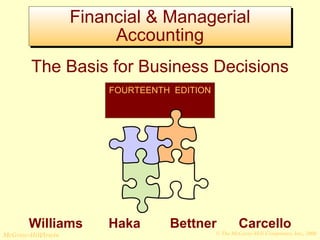Int To Acct Lecture 1
- 1. Financial & Managerial Accounting The Basis for Business Decisions FOURTEENTH EDITION Williams Haka Bettner Carcello
- 2. Accounting Information for Decision Making Chapter 1
- 3. Accounting information The accounting process Decision makers Economic activities Actions (decisions) Accounting âlinksâ decision makers with economic activities ïū and with the results of their decisions.
- 4. Accounting is an information system that 1) identifies, 2) records, and 3) communicates the economic events of an organization to interested users WHAT IS ACCOUNTING?
- 5. Identification Select economic events (transactions) Recording Record, classify and summarize Prepare accounting reports Analyze and interpret for users Communication ILLUSTRATION 1-1 THE ACCOUNTING PROCESS Accounting Reports SOFTBYTE Annual Report
- 6. Accounting 1 Includes bookkeeping 2 Also includes much more Bookkeeping 1 Involves only the recording of economic events 2 Is just one part of accounting BOOKKEEPING DISTINGUISHED FROM ACCOUNTING
- 7. Types of Accounting Information Financial Managerial Tax
- 8. Accounting Systems An accounting system consists of the personnel, procedures, technology, and records used by an organization to develop accounting information and to communicate this information to decision makers.
- 9. Information Users Investors Creditors Managers Owners Customers Employees Regulators -SEC Decisions Supported Performance evaluations Stock investments Tax strategies Labor relations Resource allocations Lending decisions Borrowing Information System Financial Information Provided Profitability Financial position Cash flows
- 10. Basic Functions of an Accounting System Interpret and record business transactions. Summarize and communicate information to decision makers. Classify similar transactions into useful reports.
- 11. Components of Internal Control Control Environment Risk Assessment Control Activities Information and Communication Monitoring
- 12. External Users of Accounting Information Owners Creditors Potential investors Labor unions Governmental agencies Suppliers Customers Trade associations General public
- 13. ILLUSTRATION 1-3 QUESTIONS ASKED BY EXTERNAL USERS Is the company earning satisfactory income? Will the company be able to pay its debts as they come due? How does the company compare in size and profitability with its competitors? What do we do if they catch us?
- 14. Objectives of External Financial Reporting Provide information about economic resources, claims to resources, and changes in resources and claims. Provide information useful in assessing amount, timing and uncertainty of future cash flows. Provide information useful in making investment and credit decisions. (Specific) (General)
- 15. Objectives of External Financial Reporting The primary financial statements. Income Statement Balance Sheet Statement of Cash Flows
- 16. Characteristics of Externally Reported Information A Means to an End Broader than Financial Statements Historical in Nature Results from Inexact and Approximate Measures Based on General-Purpose Assumption Usefulness Enhanced via Explanation
- 17. Users of Internal Accounting Information Board of directors Chief executive officer (CEO) Chief financial officer (CFO) Vice presidents Business unit managers Plant managers Store managers Line supervisors
- 18. ILLUSTRATION 1-2 QUESTIONS ASKED BY INTERNAL USERS Is cash sufficient to pay bills? What is the cost of manufacturing each unit of product? Can we afford to give employee pay raises this year? Which product line is the most profitable?
- 19. Objectives of Management Accounting Information To help achieve goals and missions To help evaluate and reward decision makers
- 20. Characteristics of Management Accounting Information Timeliness Identify Decision Maker Oriented Toward Future Measures of Efficiency and Effectiveness A Means to an End
- 21. Integrity of Accounting Information Institutional Features Generally Accepted Accounting Principles (GAAP) Financial Accounting Standards Board International Accounting Standards Board Securities and Exchange Commission Public Company Accounting Oversight Board Audits of Financial Statements Legislation
- 22. Ethics - standards of conduct by which oneâs actions are judged as right or wrong, honest or dishonest. Competence, Confidentiality, Integrity, Objectivity Generally Accepted Accounting Principles - primarily established by the Financial Accounting Standards Board and the Securities and Exchange Commission Assumptions 1 Monetary Unit - only transaction data that can be expressed in terms of money is included in the accounting records. 2 Economic Entity - includes any organization or unit in society. THE BUILDING BLOCKS OF ACCOUNTING
- 23. Integrity of Accounting Information Competence, Judgment and Ethical Behavior Certified Public Accountants (CPAs) Certificate in Management Accounting (CMA) Certificate in Internal Auditing (CIA)
- 24. Public accountants offer expert service to the general public through the services they perform. Private accountants are employees of individual companies and are involved in a number of activities including cost and tax accounting, systems, and internal auditing. Not for Profit accounting includes reporting and control for government units, foundations, hospitals, labor unions, colleges/universities, and charities. THE ACCOUNTING PROFESSION
- 25. ACCOUNTING CAREER LADDER 10+ years 6 to 8 years 2 to 4+ years Entry level Partner Public Accounting Audit Manager Senior Auditor Junior Auditor Private Accounting VP Finance and Chief Financial Officer Corporate Controller Senior Accountant Junior Accountant
- 26. End of Chapter 1


























